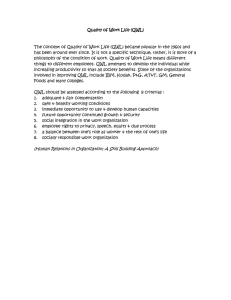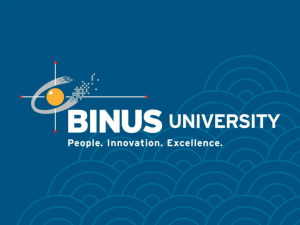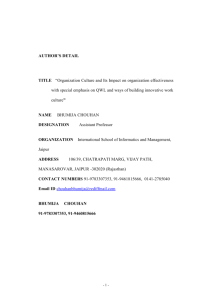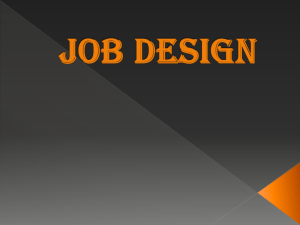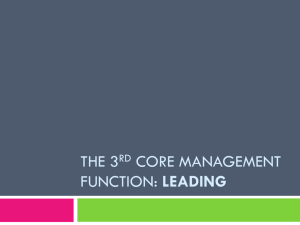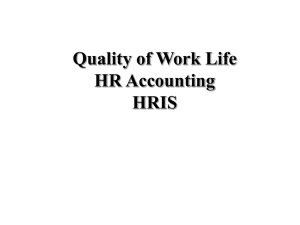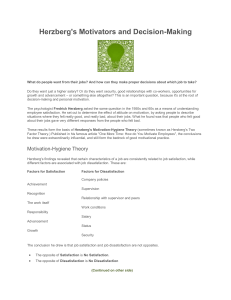Module 5 Job design and employee reactions to work
advertisement
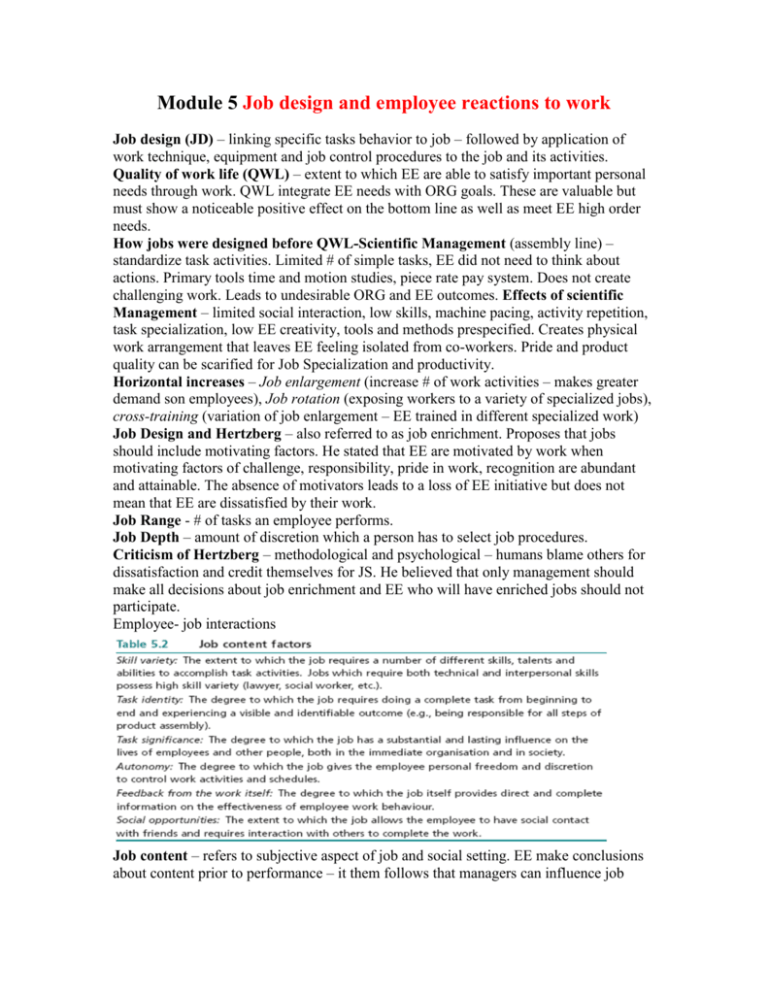
Module 5 Job design and employee reactions to work Job design (JD) – linking specific tasks behavior to job – followed by application of work technique, equipment and job control procedures to the job and its activities. Quality of work life (QWL) – extent to which EE are able to satisfy important personal needs through work. QWL integrate EE needs with ORG goals. These are valuable but must show a noticeable positive effect on the bottom line as well as meet EE high order needs. How jobs were designed before QWL-Scientific Management (assembly line) – standardize task activities. Limited # of simple tasks, EE did not need to think about actions. Primary tools time and motion studies, piece rate pay system. Does not create challenging work. Leads to undesirable ORG and EE outcomes. Effects of scientific Management – limited social interaction, low skills, machine pacing, activity repetition, task specialization, low EE creativity, tools and methods prespecified. Creates physical work arrangement that leaves EE feeling isolated from co-workers. Pride and product quality can be scarified for Job Specialization and productivity. Horizontal increases – Job enlargement (increase # of work activities – makes greater demand son employees), Job rotation (exposing workers to a variety of specialized jobs), cross-training (variation of job enlargement – EE trained in different specialized work) Job Design and Hertzberg – also referred to as job enrichment. Proposes that jobs should include motivating factors. He stated that EE are motivated by work when motivating factors of challenge, responsibility, pride in work, recognition are abundant and attainable. The absence of motivators leads to a loss of EE initiative but does not mean that EE are dissatisfied by their work. Job Range - # of tasks an employee performs. Job Depth – amount of discretion which a person has to select job procedures. Criticism of Hertzberg – methodological and psychological – humans blame others for dissatisfaction and credit themselves for JS. He believed that only management should make all decisions about job enrichment and EE who will have enriched jobs should not participate. Employee- job interactions Job content – refers to subjective aspect of job and social setting. EE make conclusions about content prior to performance – it them follows that managers can influence job performance by changing job content. Has six factors (skill variety, task identity, task significance, - examples of job range autonomy, feedback represent job depth Critical psychological states are employee reactions to the job content factors. Growth need strength – EE with high growth need (highly motivated) if job has low growth potential ->will exhibit low motivation, low performance job dissatisfaction and absenteeism. EE with low growth needs strength do not prefer jobs with extensive job content factors. JD is effective with high growth needs strength and few job content factors. Advantages of Job Characteristics model – more valid in describing how employees interact psychologically with their jobs, pinpoints job content factors that may need to change, shoes how new job design can lead to motivation, job satisfaction , performance JD principles – horizontal job loading – job range can be expanded by (job rotation, enlargement, cross-training) Vertical job loading – influence the planning of doing components. More control, autonomy, challenge, direct responsibility. Also be called increasing job depth. Methods – 1. Provide direct feedback, 2. Opportunity to learn new skills, 3. Influence to schedule work, 4 jobs should be given unique qualities, 5. Control over job resources, 6. Personal accountability should be increased. Other approaches to Job design – four day work week, job sharing, telecommuting, flextime. Interest in JD: 1. alters the relationship between people and job, 2. changes behavior; 3.provides opportunities for initiating other changes, 4.helps ORG satisfy EE needs. Problems with JD: - technology, costs, failure to consider employee preference, managerial and union resistance Team approach to JD - autonomous work group represent a team approach to JD. Socio-technical systems theory – has two elements, social (social and interpersonal) and technical (operational, equipment and technical. mechanical). Integrates 2 opposing forces in the design of work 1. Scientific management and 2, human needs and interpersonal aspects of behavior. Rewards, bonuses and pay raises are contingent on group performance members come to value interdependence and collaboration. How managers design self – directed teams – 1. Team should be small, 8 – 20. 2. Sensitivity training should be avoided- only skill bases or cross training should be provided. 3. Pay determined by team performance.4. Supervisor role should be horizontal integrator 5. Team should – plan, organize, and be responsible for quality performance New responsibilities for managers – training and development, quality control, performance evaluating, interviewing, hiring, control and discipline. Figure 5.3 Preconditions for empowerment – 1. Capability to become psychologically involved, motivation, relevance of participation for one’s own well being. Participation by employees is a core element of job design – Participation has 3 important features. 1. Psychological involvement. 2. Motivation to contribute 3. Acceptance of authority System I – ignores importance of teamwork system 4 places teamwork at the core. Prerequisites for manages to use empowerment and participation 1. EE must be trained to be effective members of empowered self directed teams 2. Managers must practice system 4 principles. 3. Must believe that EE have or can develop high growth needs strength. 4. EE must view participation as central 5. EE must have ability to attack problems. 6. EE mist use common terminology 7. EE and managers must accept that – part of creating and sustain competitive advantage. Alternatives to empowered –self direct4ed teams Scanlon plan – sets up a series of interlocking employees committees for 1. Reviewing work procedures, evaluating work suggestions for increasing productivity and cutting costs. 3. Involving EE in production decision making. This plan allocates group based bonuses to employees who exceed historical standards. Portion of the gains are set aside for the company, portion for when work group is unable to exceed historical production, EE receive at least 50%. Depends on productivity improvements suggestions from employees. Benefits – greater employee participation. Wider acceptance of changes to work procedures, increased output, better worker management relations Limits to Participation in ORGS Industry barriers, 2 global competitors over look industry because it is too small, 3. Productivity gains can still be achieved, 4. ORG already has a lean production system. 5. EE jobs are specialized. 6. EE may not have ability. 7. Employees may have insufficient growth need strength. 8. Unions. 9. May have to lay off middle managers highly qualified. 10. ORG may lose the way Summary Points • QWL (quality of work life) program have become more common in industry and they represent organizational efforts to help employees satisfy important personal needs through their work experiences. • Scientific management is the traditional approach to job design which breaks jobs down into their elements and recombines the core elements to create the most efficient job design. It always results in more specialized and simplified jobs. It is often associated with employee alienation, turnover, absenteeism and lowered production quality. • Herzberg’s two factor theory proposes that the absence of hygiene leads to job dissatisfaction while the presence of motivators leads to job satisfaction, motivation and performance, if hygiene’s are present. While Herzberg’s theory has been criticized on research grounds, it was the first significant departure from scientific management as a method for job design. • Job range refers to the number of tasks performed by an employee, while job depth is the amount of discretion the employee has to select various job procedures to accomplish work. When these two principles are applied to job design, they are referred to as horizontal and vertical job loading respectively. • Employee perceptions of job content factors (Herzberg’s motivators) are believed to precede job performance. Therefore, managers must be alert to opportunities to enhance the motivating potential of jobs. • Job content factors are skill variety, task identity, task significance, social opportunities, autonomy and feedback. • Employee growth need strength is an individual difference composed of achievement, interest in work, challenge, desire for independence and personal control over work. It is a moderating factor which must be considered prior to attempting changes in job design. • Job rotation increases levels of employee skills by moving them from one job to a related one for a given period of time. Job enlargement expands task identity by adding related tasks to the employee’s core work activity. Managers may resist efforts to change job designs because they are unwilling to delegate authority. • Self-directed teams are organizational arrangements which integrate the technical and social aspects of group work. Countless companies are adopting this type of job design to exploit new forms of competitive advantage based on improvements in the design of work. • Empowerment is the sharing of decision-making power by the organization with its employees. It is commonly found in companies that support participation and exhibit features of System 4 organizations. • Participation is composed of three elements: 1) psychological and physical job involvement, 2) motivation to contribute and 3) acceptance of responsibility. • System 4 organizations use participation and empowerment in job designs to raise individual and work team effectiveness. Managers who wish to use participation more effectively must value participation and also must give employees the opportunity to become accustomed to the behaviors required by participation. • The Scanlon Plan is a form of managed participation which focuses employees’ attention on receiving group based rewards for achieving productivity gains.
